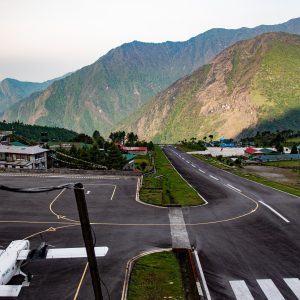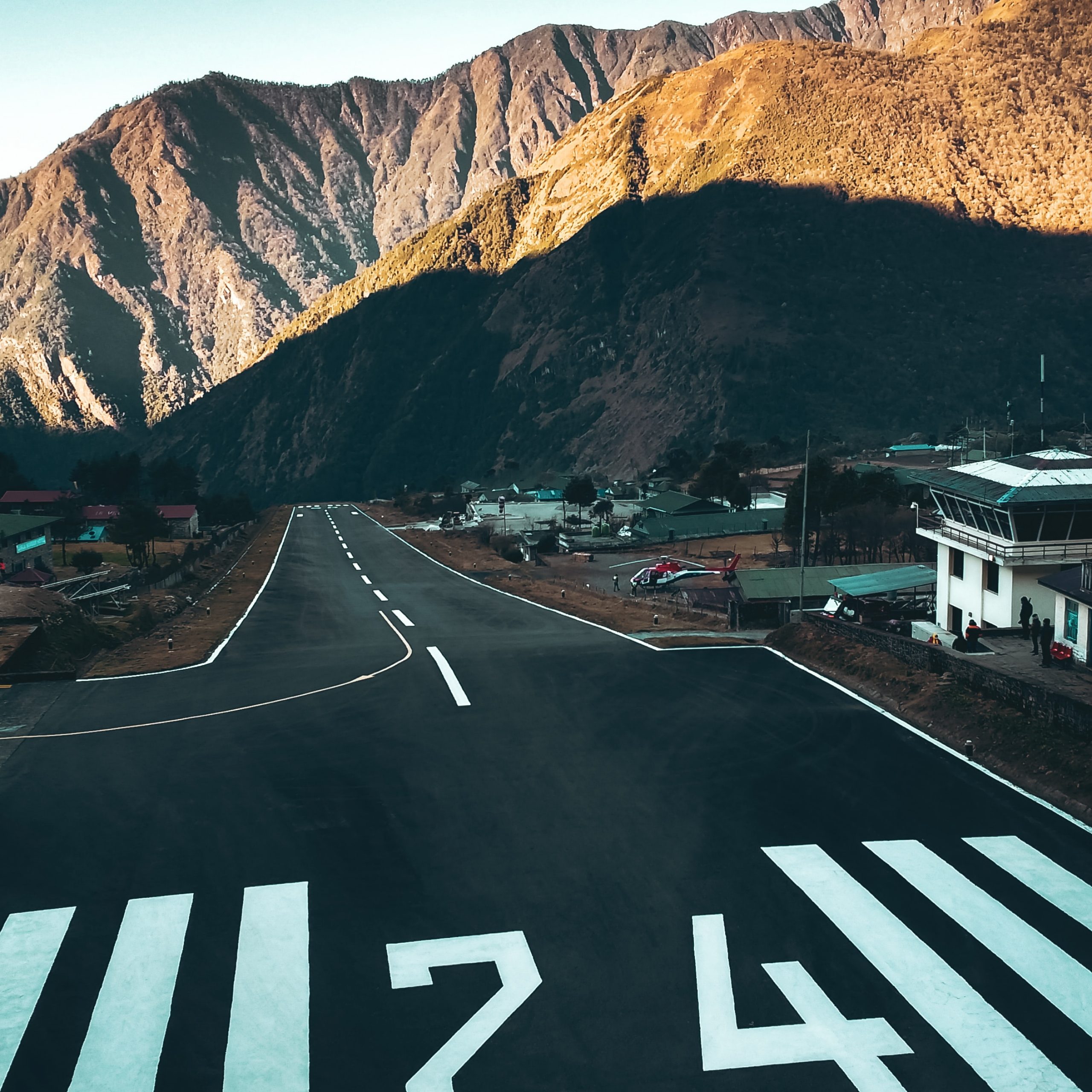Lukla Airport, also known as Tenzing-Hillary Airport, is a small and challenging airport located in the town of Lukla in the Khumbu region of eastern Nepal. It is one of the most famous and dangerous airports in the world due to its short and sloping runway, high altitude (2,845 meters or 9,334 feet), and challenging weather conditions.
The Lukla Airport is the main gateway for trekkers and mountaineers heading to the Everest region to embark on their journey to Mount Everest Base Camp. Lukla Airport plays a crucial role in supporting the tourism and trekking industry in the Everest region.
Lukla airport’s runway is only about 527 meters (1,729 feet) long and has a significant slope with a gradient of 12%. The short runway and challenging terrain make landing and taking off at Lukla Airport a skilled and risky endeavor, especially for pilots. The airport has become iconic in the world of aviation due to its unique challenges and the breathtaking Himalayan scenery surrounding it.
Many flights to Lukla are operated by small aircraft, typically the Twin Otter and Dornier, which are well-suited for the demanding conditions of the airport. Flights to Lukla are often dependent on weather conditions, and delays or cancellations are not uncommon, adding to the adventurous nature of reaching this remote and beautiful destination.

History:
Lukla Airport, also known as Tenzing-Hillary Airport, was named in honor of Sir Edmund Hillary of New Zealand and Tenzing Norgay, a Sherpa of Nepal, who were the first climbers to reach the summit of Mount Everest in 1953. The airport was originally built by Sir Edmund Hillary to facilitate the construction of the Hillary-Tenzing airstrip, which was intended to support the Khumbu region.
Features:
- Short Runway: The runway at Lukla is exceptionally short, measuring about 527 meters (1,729 feet). This limits the types of aircraft that can operate there.
- Slope: The runway has a significant slope with a gradient of approximately 12%, making it one of the steepest runways in the world.
- Altitude: Lukla is situated at an altitude of 2,845 meters (9,334 feet). The high altitude presents challenges for both aircraft performance and passengers acclimatizing to the thin air.
- Challenging Weather Conditions: Lukla is prone to unpredictable and rapidly changing weather conditions, including fog, high winds, and low visibility. These factors can lead to delays and cancellations of flights.
- Surrounded by Mountains: The Lukla Airport is surrounded by high mountains, adding an extra layer of complexity to takeoffs and landings.
Risks:
- Accidents: Due to the challenging nature of the airport, there have been instances of accidents and incidents, including runway overruns and crashes. Pilots need specialized training to handle the unique conditions at Lukla.
- Weather-Dependent Operations: Flights to and from Lukla are highly dependent on weather conditions. Sudden changes in weather can result in delays, diversions, or cancellations.
- Limited Aircraft: Only certain types of aircraft, particularly the Twin Otter and Dornier, are suitable for operations at Lukla. The limited options make it challenging for airlines and trekkers.
- High Altitude: The high altitude of Lukla increases the risk of altitude-related issues for both passengers and flight crews.
Despite the risks, Lukla Airport remains a vital gateway for trekkers and climbers heading to the Everest region, offering a unique and adventurous experience for those willing to embark on the journey to this remote part of the Himalayas.
Why Lukla Airport Is World’s Dangerous Airport?
Lukla Airport is considered dangerous due to a combination of challenging factors associated with its location, terrain, and weather conditions. Here are some key reasons why Lukla Airport is considered dangerous:
- Short Runway: Lukla Airport has one of the shortest runways in the world, measuring about 527 meters (1,729 feet). The limited runway length poses challenges for both takeoffs and landings, requiring precise maneuvering by pilots.
- Slope: The runway at Lukla has a significant slope with a gradient of approximately 12%. The uphill slope on landing and downhill slope on takeoff add complexity to aircraft operations.
- High Altitude: Lukla is situated at an altitude of 2,845 meters (9,334 feet). The high altitude affects aircraft performance, as engines produce less power and aircraft require longer distances to take off and land.
- Challenging Approach: Pilots approaching Lukla face a challenging and visually demanding approach through the narrow valley surrounded by high mountain terrain. The approach involves navigating through varying weather conditions, including fog and low visibility.
- Weather Conditions: Lukla experiences unpredictable and rapidly changing weather conditions, including high winds, fog, and cloud cover. Weather fluctuations can lead to sudden changes in visibility, making landings and takeoffs more hazardous.
- Limited Go-Around Options: The challenging terrain surrounding Lukla restricts the options for go-arounds during aborted landings. Pilots must commit to landings early in the approach, leaving limited room for corrections.
- Runway Surface: The runway surface at Lukla is unpaved, consisting of gravel and uneven terrain. This can make for a rough landing and adds to the complexity of operations, especially during adverse weather conditions.
- Limited Aircraft Types: Due to the short runway and challenging conditions, only certain types of aircraft, such as the Twin Otter and Dornier, are suitable for operations at Lukla. Larger aircraft are not able to operate at this airport.
- High Traffic Volume: Lukla experiences a high volume of air traffic, particularly during the trekking and climbing seasons. The combination of a short runway and a busy airport increases the risk of incidents.
Despite these challenges, Lukla Airport remains a vital gateway for trekkers and climbers heading to the Everest region. Pilots flying to Lukla undergo specialized training to handle the unique conditions, and safety measures are continually reviewed and improved to mitigate risks associated with operating at this airport.
Key Services:-
Here are some of the key services typically available at Lukla Airport:
- Flight Services: Lukla Airport serves as a domestic airport, connecting the region to Kathmandu, the capital of Nepal. Flights are mainly operated by small aircraft, such as Twin Otter and Dornier, to transport passengers and cargo.
- Terminal Facilities: The Lukla Airport has a small terminal building where passengers can check in for their flights. However, the facilities are basic, and amenities are limited.
- Baggage Handling: Lukla Airport provides basic baggage handling services. Passengers are usually allowed a limited amount of luggage due to the small size of the aircraft and weight restrictions.
- Customs and Immigration: While Lukla is a domestic airport, there may be some basic customs and immigration services in place, especially for flights arriving from Kathmandu.
- Ground Handling: Ground handling services are essential at Lukla Airport to assist with aircraft movements on the ground, including parking, refueling, and other necessary services.
- Information Desk: There may be a small information desk or airport staff available to assist passengers with inquiries and provide basic information about flights and the local area.
- Medical Services: Given the high altitude and the potential for altitude-related issues, there may be basic medical services or first aid available at the airport. In case of emergencies, medical evacuation options may be coordinated.
- Weather Updates: Given the challenging weather conditions in the region, the airport may provide weather updates to keep passengers informed about any potential flight disruptions.
Please Follow Us For more Updates :
Website : Base Camp Trip

